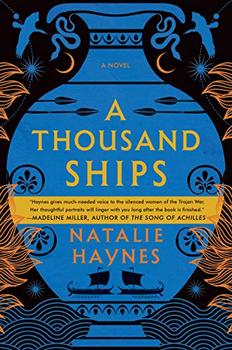Summary | Excerpt | Reviews | Beyond the Book | Read-Alikes | Genres & Themes | Author Bio

Critics' Opinion:
Readers' Opinion:
First Published:
Jan 2021, 368 pages
Paperback:
Oct 2021, 368 pages
 Book Reviewed by:
Book Reviewed by:
Will Heath
Buy This Book
This article relates to A Thousand Ships
 The story of the Trojan War, fought between the Greeks and the people of Troy, has been told and retold for thousands of years. This is in large part thanks to the efforts of Homer, the ancient Greek poet who penned the Iliad and Odyssey, recordings of epic stories set during and after the war. Legendary figure Helen of Troy plays a significant role in depictions of the conflict, which is said to have been sparked when she was whisked away from her husband Menelaus, king of Sparta, by the Trojan prince Paris. But did the Trojan War actually happen, even if it didn't occur exactly as Homer and his contemporaries described it? Where was Troy and who was Helen?
The story of the Trojan War, fought between the Greeks and the people of Troy, has been told and retold for thousands of years. This is in large part thanks to the efforts of Homer, the ancient Greek poet who penned the Iliad and Odyssey, recordings of epic stories set during and after the war. Legendary figure Helen of Troy plays a significant role in depictions of the conflict, which is said to have been sparked when she was whisked away from her husband Menelaus, king of Sparta, by the Trojan prince Paris. But did the Trojan War actually happen, even if it didn't occur exactly as Homer and his contemporaries described it? Where was Troy and who was Helen?
As explained in a BBC article by Daisy Dunn, the Greek historian Herodotus, who lived in the 5th century BCE, placed the Trojan War nearly 800 years previous to his own time, within the late Bronze Age. When the poets and playwrights of ancient Greece were telling stories of the war, they generally believed it to have really occurred. But its events, even for them, would have been a distant cultural memory.
In the late-19th century CE, a Prussian businessman by the name of Heinrich Schliemann set out with the intention of finding the site where Troy had been located. The artifacts that he eventually discovered at Hisarlik, on the west coast of Turkey, did indeed suggest the existence of the city. As Dunn explains, "Most historians now agree that ancient Troy was to be found at Hisarlik. Troy was real."
So if the consensus today is that Troy once existed in what is now Turkey, does that also mean the events of the Trojan War happened? Evidence of fire and weapons found in the area suggest the possibility of warfare. Ancient inscriptions also tell of a conflict over the city. However, Dunn writes, "It is hard to imagine a war taking place on quite the scale the poet described, and lasting as long as 10 years when the citadel was fairly compact." As for Helen of Troy, she seems to have been a fantasy. If the Trojan War never happened, at least as Homer depicted it, then Helen likely never existed either.
In another BBC article, historian Bettany Hughes discusses what we know about the real-life basis for the character of Helen, explaining that "there were indeed high-ranking female aristocrats whose infidelity was enough to spark threats of war" and that Helen appears to be "a combination of real flesh and blood women of the day, and salivating fantasies about female sexuality combined with a sharp fear of female power." Hughes' comments culminate in a rather inspiring observation: "[T]he delight of Helen's story, if you read Homer carefully, is that it offers a glimpse of actual women in Europe and Asia who enjoyed status and standing and agency. When women were generally written out of history, Helen of Troy was written in."
To conclude, Troy was real, Helen was likely not, and the Trojan War — if it did happen — was not the 10-year-long epic that Homer described. Nevertheless, these stories have already lasted for millennia, and will likely last as long as humanity does.
Head of Helen of Troy, painting by Guido Reni (1575-1642) located at the National Trust in London. Source: Art UK
Filed under People, Eras & Events
![]() This "beyond the book article" relates to A Thousand Ships. It originally ran in February 2021 and has been updated for the
October 2021 paperback edition.
Go to magazine.
This "beyond the book article" relates to A Thousand Ships. It originally ran in February 2021 and has been updated for the
October 2021 paperback edition.
Go to magazine.





The Flower Sisters
by Michelle Collins Anderson
From the new Fannie Flagg of the Ozarks, a richly-woven story of family, forgiveness, and reinvention.

The House on Biscayne Bay
by Chanel Cleeton
As death stalks a gothic mansion in Miami, the lives of two women intertwine as the past and present collide.

The Funeral Cryer by Wenyan Lu
Debut novelist Wenyan Lu brings us this witty yet profound story about one woman's midlife reawakening in contemporary rural China.
Your guide toexceptional books
BookBrowse seeks out and recommends the best in contemporary fiction and nonfiction—books that not only engage and entertain but also deepen our understanding of ourselves and the world around us.